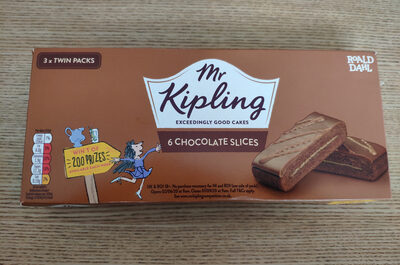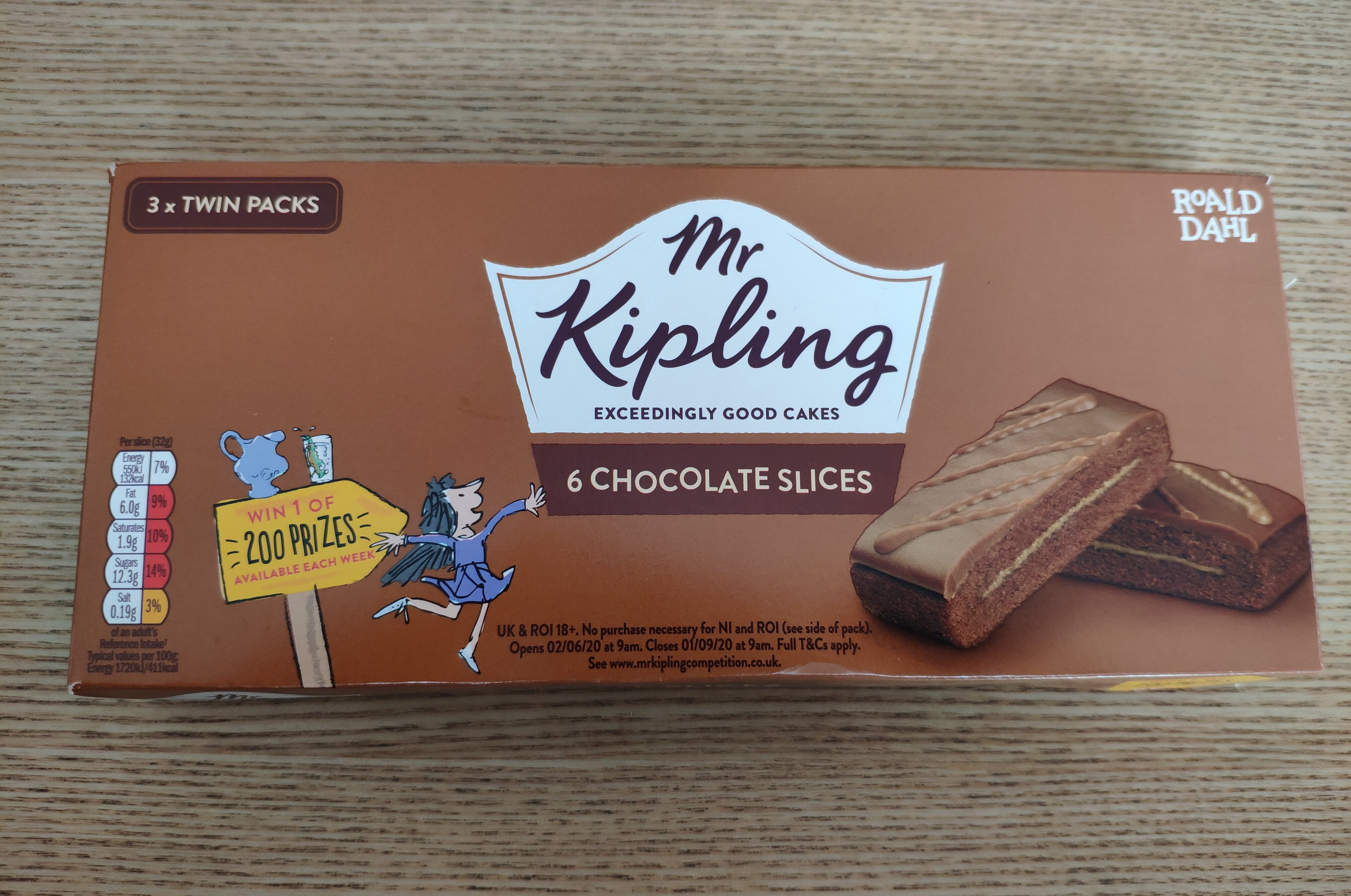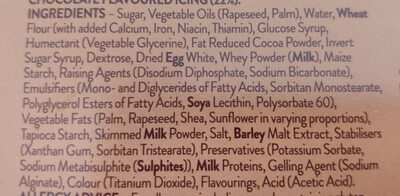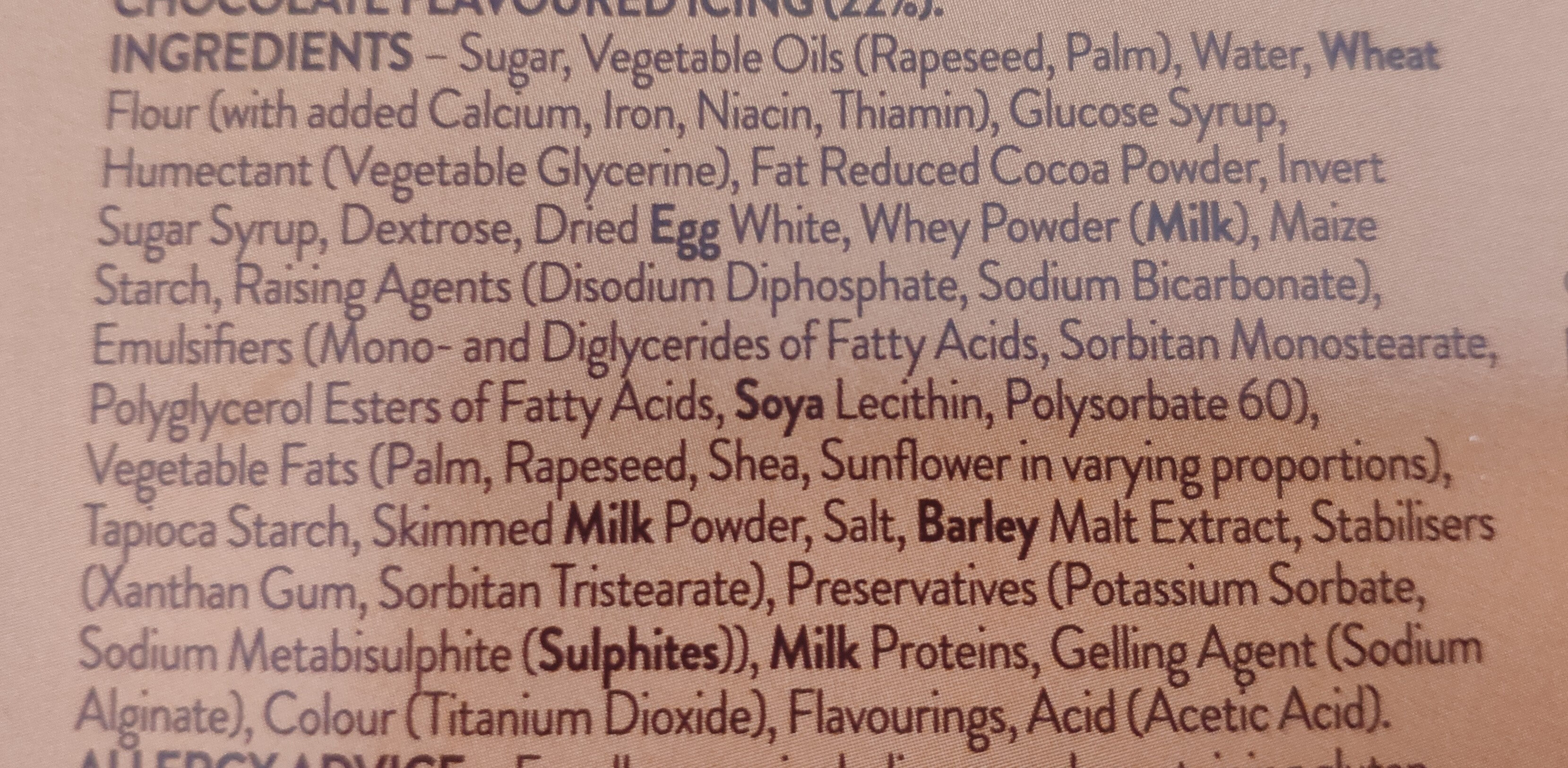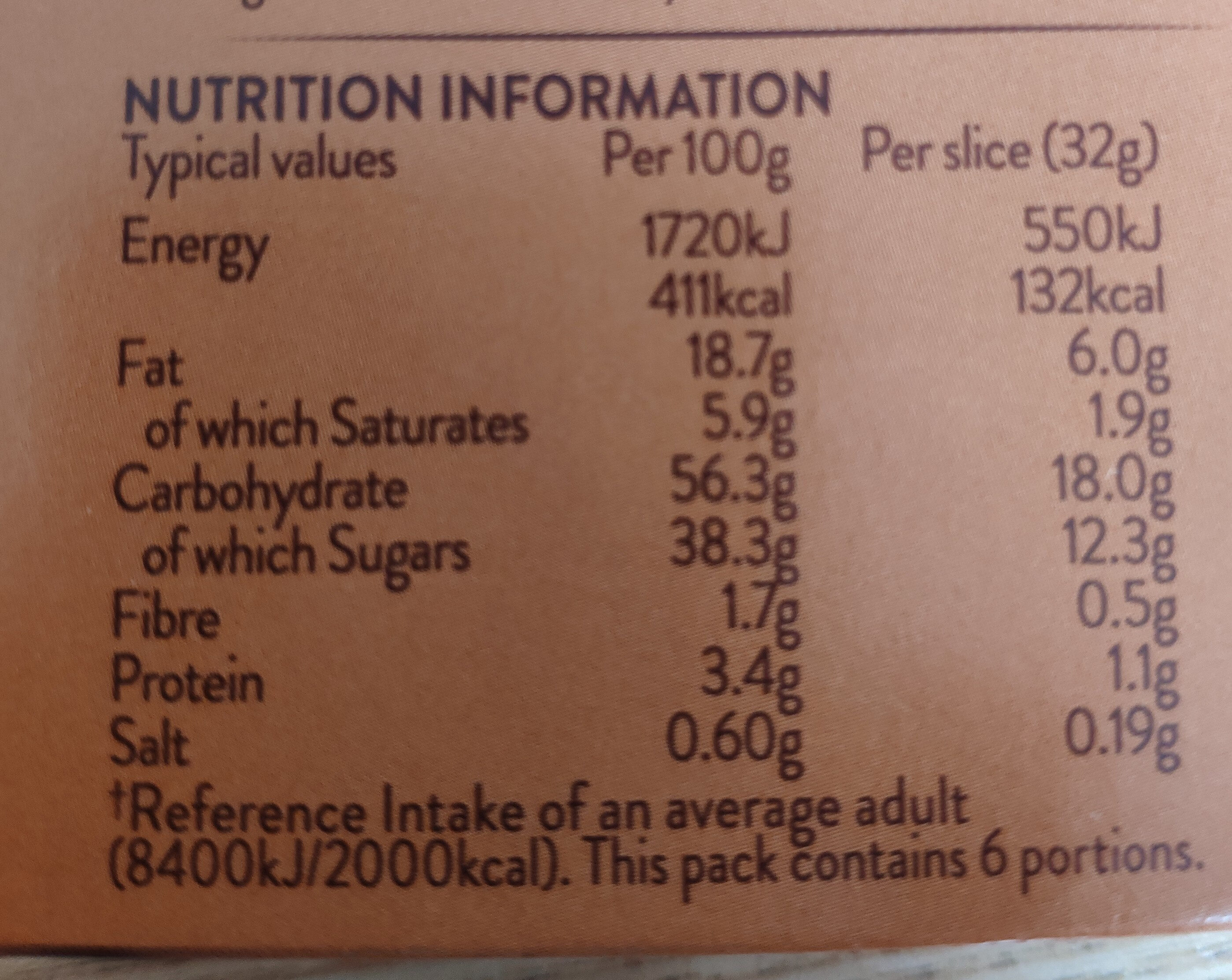Help us make food transparency the norm!
As a non-profit organization, we depend on your donations to continue informing consumers around the world about what they eat.
The food revolution starts with you!
Mr Kipling 6 Chocolate Slices
Mr Kipling 6 Chocolate Slices
This product page is not complete. You can help to complete it by editing it and adding more data from the photos we have, or by taking more photos using the app for Android or iPhone/iPad. Thank you!
×
Barcode: 5000221601890 (EAN / EAN-13)
Common name: Chocolate flavoured sponge with a chocolate flavour filling (13%), topped with a decorated chocolate flavoured icing (22%)
Brands: Mr Kipling
Categories: Snacks, Desserts, Sweet snacks, Biscuits and cakes, Cakes, Sponge cakes, Filled sponge cake slices, Sponge cake filled and covered with chocolate
Labels, certifications, awards: Vegetarian, Natural flavors, No artificial colors, No hydrogenated fats
Manufacturing or processing places: United Kingdom
Link to the product page on the official site of the producer: https://www.mrkipling.co.uk/our-ranges/f...
Stores: Asda
Countries where sold: United Kingdom, United States
Matching with your preferences
Health
Ingredients
-
50 ingredients
Sugar, Vegetable Oils (Rapeseed, Palm), Water, Wheat Flour (with added Calcium, Iron, Niacin, Thiamin), Glucose Syrup, Humectant (Vegetable Glycerine), Fat Reduced Cocoa Powder, Invert Sugar Syrup, Dextrose, Dried Egg White, Whey Powder (Milk), Maize Starch, Raising Agents (Disodium Diphosphate, Sodium Bicarbonate), Emulsifiers (Mono - and Diglycerides of Fatty Acids, Sorbitan Monostearate, Polyglycerol Esters of Fatty Acids, Soya Lecithin, Polysorbate 60), Vegetable Fats (Palm, Rapeseed, Shea, Sunflower in varying proportions), Tapioca Starch, Skimmed Milk Powder, Salt, Barley Malt Extract, Stabilisers (Xanthan Gum, Sorbitan Tristearate), Preservatives (Potassium Sorbate, Sodium Metabisulphite (Sulphites)), Milk Proteins, Gelling Agent (Sodium Alginate), Colour (Titanium Dioxide), Flavourings, Acid (Acetic Acid).Allergens: Eggs, Gluten, Milk, Soybeans, Sulphur dioxide and sulphitesTraces: Nuts
Food processing
-
Ultra processed foods
Elements that indicate the product is in the 4 - Ultra processed food and drink products group:
- Additive: E171 - Titanium dioxide
- Additive: E322 - Lecithins
- Additive: E401 - Sodium alginate
- Additive: E415 - Xanthan gum
- Additive: E422 - Glycerol
- Additive: E435 - Polyoxyethylene sorbitan monostearate
- Additive: E450 - Diphosphates
- Additive: E471 - Mono- and diglycerides of fatty acids
- Additive: E475 - Polyglycerol esters of fatty acids
- Additive: E491 - Sorbitan monostearate
- Additive: E492 - Sorbitan tristearate
- Ingredient: Colour
- Ingredient: Dextrose
- Ingredient: Emulsifier
- Ingredient: Flavouring
- Ingredient: Gelling agent
- Ingredient: Glucose
- Ingredient: Glucose syrup
- Ingredient: Humectant
- Ingredient: Invert sugar
- Ingredient: Milk proteins
- Ingredient: Whey
Food products are classified into 4 groups according to their degree of processing:
- Unprocessed or minimally processed foods
- Processed culinary ingredients
- Processed foods
- Ultra processed foods
The determination of the group is based on the category of the product and on the ingredients it contains.
Additives
-
E171 - Titanium dioxide
Titanium dioxide: Titanium dioxide, also known as titaniumIV oxide or titania, is the naturally occurring oxide of titanium, chemical formula TiO2. When used as a pigment, it is called titanium white, Pigment White 6 -PW6-, or CI 77891. Generally, it is sourced from ilmenite, rutile and anatase. It has a wide range of applications, including paint, sunscreen and food coloring. When used as a food coloring, it has E number E171. World production in 2014 exceeded 9 million metric tons. It has been estimated that titanium dioxide is used in two-thirds of all pigments, and the oxide has been valued at $13.2 billion.Source: Wikipedia
-
E202 - Potassium sorbate
Potassium sorbate (E202) is a synthetic food preservative commonly used to extend the shelf life of various food products.
It works by inhibiting the growth of molds, yeast, and some bacteria, preventing spoilage. When added to foods, it helps maintain their freshness and quality.
Some studies have shown that when combined with nitrites, potassium sorbate have genotoxic activity in vitro. However, potassium sorbate is generally recognized as safe (GRAS) by regulatory authorities.
-
E223 - Sodium metabisulphite
Sodium metabisulfite: Sodium metabisulfite or sodium pyrosulfite -IUPAC spelling; Br. E. sodium metabisulphite or sodium pyrosulphite- is an inorganic compound of chemical formula Na2S2O5. The substance is sometimes referred to as disodium metabisulfite. It is used as a disinfectant, antioxidant, and preservative agent.Source: Wikipedia
-
E260 - Acetic acid
Acetic acid: Acetic acid , systematically named ethanoic acid , is a colorless liquid organic compound with the chemical formula CH3COOH -also written as CH3CO2H or C2H4O2-. When undiluted, it is sometimes called glacial acetic acid. Vinegar is no less than 4% acetic acid by volume, making acetic acid the main component of vinegar apart from water. Acetic acid has a distinctive sour taste and pungent smell. In addition to household vinegar, it is mainly produced as a precursor to polyvinyl acetate and cellulose acetate. It is classified as a weak acid since it only partially dissociates in solution, but concentrated acetic acid is corrosive and can attack the skin. Acetic acid is the second simplest carboxylic acid -after formic acid-. It consists of a methyl group attached to a carboxyl group. It is an important chemical reagent and industrial chemical, used primarily in the production of cellulose acetate for photographic film, polyvinyl acetate for wood glue, and synthetic fibres and fabrics. In households, diluted acetic acid is often used in descaling agents. In the food industry, acetic acid is controlled by the food additive code E260 as an acidity regulator and as a condiment. In biochemistry, the acetyl group, derived from acetic acid, is fundamental to all forms of life. When bound to coenzyme A, it is central to the metabolism of carbohydrates and fats. The global demand for acetic acid is about 6.5 million metric tons per year -Mt/a-, of which approximately 1.5 Mt/a is met by recycling; the remainder is manufactured from methanol. Vinegar is mostly dilute acetic acid, often produced by fermentation and subsequent oxidation of ethanol.Source: Wikipedia
-
E322 - Lecithins
Lecithins are natural compounds commonly used in the food industry as emulsifiers and stabilizers.
Extracted from sources like soybeans and eggs, lecithins consist of phospholipids that enhance the mixing of oil and water, ensuring smooth textures in various products like chocolates, dressings, and baked goods.
They do not present any known health risks.
-
E322i - Lecithin
Lecithins are natural compounds commonly used in the food industry as emulsifiers and stabilizers.
Extracted from sources like soybeans and eggs, lecithins consist of phospholipids that enhance the mixing of oil and water, ensuring smooth textures in various products like chocolates, dressings, and baked goods.
They do not present any known health risks.
-
E415 - Xanthan gum
Xanthan gum (E415) is a natural polysaccharide derived from fermented sugars, often used in the food industry as a thickening and stabilizing agent.
This versatile food additive enhances texture and prevents ingredient separation in a wide range of products, including salad dressings, sauces, and gluten-free baked goods.
It is considered safe for consumption even at high intake amounts.
-
E422 - Glycerol
Glycerol: Glycerol -; also called glycerine or glycerin; see spelling differences- is a simple polyol compound. It is a colorless, odorless, viscous liquid that is sweet-tasting and non-toxic. The glycerol backbone is found in all lipids known as triglycerides. It is widely used in the food industry as a sweetener and humectant and in pharmaceutical formulations. Glycerol has three hydroxyl groups that are responsible for its solubility in water and its hygroscopic nature.Source: Wikipedia
-
E450 - Diphosphates
Diphosphates (E450) are food additives often utilized to modify the texture of products, acting as leavening agents in baking and preventing the coagulation of canned food.
These salts can stabilize whipped cream and are also found in powdered products to maintain their flow properties. They are commonly present in baked goods, processed meats, and soft drinks.
Derived from phosphoric acid, they're part of our daily phosphate intake, which often surpasses recommended levels due to the prevalence of phosphates in processed foods and drinks.
Excessive phosphate consumption is linked to health issues, such as impaired kidney function and weakened bone health. Though diphosphates are generally regarded as safe when consumed within established acceptable daily intakes, it's imperative to monitor overall phosphate consumption to maintain optimal health.
-
E471 - Mono- and diglycerides of fatty acids
Mono- and diglycerides of fatty acids (E471), are food additives commonly used as emulsifiers in various processed foods.
These compounds consist of glycerol molecules linked to one or two fatty acid chains, which help stabilize and blend water and oil-based ingredients. E471 enhances the texture and shelf life of products like margarine, baked goods, and ice cream, ensuring a smooth and consistent texture.
It is generally considered safe for consumption within established regulatory limits.
-
E491 - Sorbitan monostearate
Sorbitan monostearate: Sorbitan monostearate is an ester of sorbitan -a sorbitol derivative- and stearic acid and is sometimes referred to as a synthetic wax. It is primarily used as an emulsifier to keep water and oils mixed. Sorbitan monostearate is used in the manufacture of food and healthcare products and is a non-ionic surfactant with emulsifying, dispersing, and wetting properties. It is also employed to create synthetic fibers, metal machining fluid, and brighteners in the leather industry, and as an emulsifier in coatings, pesticides, and various applications in the plastics, food and cosmetics industries. Sorbitans are also known as "Spans". Sorbitan monostearate has been approved by the European Union for use as a food additive -emulsifier- -E number: E 491-Source: Wikipedia
-
E492 - Sorbitan tristearate
Sorbitan tristearate: Sorbitan tristearate is a nonionic surfactant. It is variously used as a dispersing agent, emulsifier, and stabilizer, in food and in aerosol sprays. As a food additive, it has the E number E492. Brand names for polysorbates include Alkest, Canarcel, and Span. The consistency of sorbitan tristearate is waxy; its color is light cream to tan.Source: Wikipedia
-
E500 - Sodium carbonates
Sodium carbonates (E500) are compounds commonly used in food preparation as leavening agents, helping baked goods rise by releasing carbon dioxide when they interact with acids.
Often found in baking soda, they regulate the pH of food, preventing it from becoming too acidic or too alkaline. In the culinary world, sodium carbonates can also enhance the texture and structure of foods, such as noodles, by modifying the gluten network.
Generally recognized as safe, sodium carbonates are non-toxic when consumed in typical amounts found in food.
-
E500ii - Sodium hydrogen carbonate
Sodium hydrogen carbonate, also known as E500ii, is a food additive commonly used as a leavening agent.
When added to recipes, it releases carbon dioxide gas upon exposure to heat or acids, causing dough to rise and resulting in a light, fluffy texture in baked goods.
It is generally recognized as safe (GRAS) by regulatory authorities when used in appropriate quantities and poses no significant health risks when consumed in typical food applications.
Ingredients analysis
-
Palm oil
Ingredients that contain palm oil: Palm oil, Palm
-
Non-vegan
Non-vegan ingredients: Egg white, Whey powder, Skimmed milk powder, Milk proteins
-
Vegetarian
No non-vegetarian ingredients detected
Unrecognized ingredients: Calcium, Iron, Thiamin
-
Details of the analysis of the ingredients
: Sugar, Rapeseed Vegetable Oils, Palm Vegetable Oils, Water, _Wheat_ Flour (with added Calcium, Iron, Niacin, Thiamin), Glucose Syrup, Humectant (Vegetable Glycerine), Fat Reduced Cocoa Powder, Invert Sugar Syrup, Dextrose, _Egg_ White, Whey Powder, Maize Starch, Raising Agents (Disodium Diphosphate, Sodium Bicarbonate), Emulsifiers (mono- and Diglycerides of Fatty Acids, Sorbitan Monostearate, Polyglycerol Esters of Fatty Acids, _Soya_ Lecithin, Polysorbate 60), Vegetable Fats (Palm, Rapeseed, Shea, Sunflower in varying proportions), Tapioca Starch, Skimmed _Milk_ Powder, Salt, _Barley_ Malt Extract, Stabilisers (Xanthan Gum, Sorbitan Tristearate), Preservatives (Potassium Sorbate, Sodium Metabisulphite), _Milk_ Proteins, Gelling Agent (Sodium Alginate), Colour (Titanium Dioxide), Flavourings, Acid (Acetic Acid)- Sugar -> en:sugar - vegan: yes - vegetarian: yes - ciqual_proxy_food_code: 31016 - percent_min: 3.7037037037037 - percent_max: 100
- Rapeseed Vegetable Oils -> en:rapeseed-oil - vegan: yes - vegetarian: yes - from_palm_oil: no - percent_min: 0 - percent_max: 50
- Palm Vegetable Oils -> en:palm-oil - vegan: yes - vegetarian: yes - from_palm_oil: yes - ciqual_food_code: 16129 - percent_min: 0 - percent_max: 33.3333333333333
- Water -> en:water - vegan: yes - vegetarian: yes - ciqual_food_code: 18066 - percent_min: 0 - percent_max: 25
- _Wheat_ Flour -> en:wheat-flour - vegan: yes - vegetarian: yes - ciqual_proxy_food_code: 9410 - percent_min: 0 - percent_max: 20
- with added Calcium -> en:calcium - percent_min: 0 - percent_max: 20
- Iron -> en:iron - percent_min: 0 - percent_max: 10
- Niacin -> en:e375 - vegan: maybe - vegetarian: maybe - percent_min: 0 - percent_max: 6.66666666666667
- Thiamin -> en:thiamin - percent_min: 0 - percent_max: 5
- Glucose Syrup -> en:glucose-syrup - vegan: yes - vegetarian: yes - ciqual_proxy_food_code: 31016 - percent_min: 0 - percent_max: 16.6666666666667
- Humectant -> en:humectant - percent_min: 0 - percent_max: 14.2857142857143
- Vegetable Glycerine -> en:e422 - vegan: maybe - vegetarian: maybe - percent_min: 0 - percent_max: 14.2857142857143
- Fat Reduced Cocoa Powder -> en:fat-reduced-cocoa-powder - vegan: yes - vegetarian: yes - ciqual_food_code: 18100 - percent_min: 0 - percent_max: 12.5
- Invert Sugar Syrup -> en:invert-sugar-syrup - vegan: yes - vegetarian: yes - percent_min: 0 - percent_max: 11.1111111111111
- Dextrose -> en:dextrose - vegan: yes - vegetarian: yes - ciqual_proxy_food_code: 31016 - percent_min: 0 - percent_max: 10
- _Egg_ White -> en:egg-white - vegan: no - vegetarian: yes - ciqual_food_code: 22001 - percent_min: 0 - percent_max: 9.09090909090909
- Whey Powder -> en:whey-powder - vegan: no - vegetarian: maybe - percent_min: 0 - percent_max: 8.33333333333333
- Maize Starch -> en:corn-starch - vegan: yes - vegetarian: yes - ciqual_food_code: 9510 - percent_min: 0 - percent_max: 7.69230769230769
- Raising Agents -> en:raising-agent - percent_min: 0 - percent_max: 7.14285714285714
- Disodium Diphosphate -> en:e450i - vegan: yes - vegetarian: yes - percent_min: 0 - percent_max: 7.14285714285714
- Sodium Bicarbonate -> en:e500ii - vegan: yes - vegetarian: yes - percent_min: 0 - percent_max: 3.57142857142857
- Emulsifiers -> en:emulsifier - percent_min: 0 - percent_max: 6.66666666666667
- mono- and Diglycerides of Fatty Acids -> en:e471 - vegan: maybe - vegetarian: maybe - from_palm_oil: maybe - percent_min: 0 - percent_max: 6.66666666666667
- Sorbitan Monostearate -> en:e491 - vegan: maybe - vegetarian: maybe - percent_min: 0 - percent_max: 3.33333333333333
- Polyglycerol Esters of Fatty Acids -> en:e475 - vegan: maybe - vegetarian: maybe - percent_min: 0 - percent_max: 2.22222222222222
- _Soya_ Lecithin -> en:soya-lecithin - vegan: yes - vegetarian: yes - ciqual_food_code: 42200 - percent_min: 0 - percent_max: 1.66666666666667
- Polysorbate 60 -> en:e435 - vegan: maybe - vegetarian: maybe - percent_min: 0 - percent_max: 1.33333333333333
- Vegetable Fats -> en:vegetable-fat - vegan: yes - vegetarian: yes - from_palm_oil: maybe - percent_min: 0 - percent_max: 6.25
- Palm -> en:palm - vegan: yes - vegetarian: yes - from_palm_oil: yes - ciqual_food_code: 16129 - percent_min: 0 - percent_max: 6.25
- Rapeseed -> en:rapeseed - vegan: yes - vegetarian: yes - percent_min: 0 - percent_max: 3.125
- Shea -> en:shea-butter - vegan: yes - vegetarian: yes - from_palm_oil: no - percent_min: 0 - percent_max: 2.08333333333333
- Sunflower in varying proportions -> en:sunflower - vegan: yes - vegetarian: yes - percent_min: 0 - percent_max: 1.5625
- Tapioca Starch -> en:tapioca - vegan: yes - vegetarian: yes - ciqual_proxy_food_code: 9510 - percent_min: 0 - percent_max: 5.88235294117647
- Skimmed _Milk_ Powder -> en:skimmed-milk-powder - vegan: no - vegetarian: yes - ciqual_food_code: 19054 - percent_min: 0 - percent_max: 5.55555555555556
- Salt -> en:salt - vegan: yes - vegetarian: yes - ciqual_food_code: 11058 - percent_min: 0 - percent_max: 0.6
- _Barley_ Malt Extract -> en:barley-malt-extract - vegan: yes - vegetarian: yes - percent_min: 0 - percent_max: 0.6
- Stabilisers -> en:stabiliser - percent_min: 0 - percent_max: 0.6
- Xanthan Gum -> en:e415 - vegan: yes - vegetarian: yes - percent_min: 0 - percent_max: 0.6
- Sorbitan Tristearate -> en:e492 - vegan: maybe - vegetarian: maybe - percent_min: 0 - percent_max: 0.3
- Preservatives -> en:preservative - percent_min: 0 - percent_max: 0.6
- Potassium Sorbate -> en:e202 - vegan: yes - vegetarian: yes - percent_min: 0 - percent_max: 0.6
- Sodium Metabisulphite -> en:e223 - vegan: yes - vegetarian: yes - percent_min: 0 - percent_max: 0.3
- _Milk_ Proteins -> en:milk-proteins - vegan: no - vegetarian: yes - percent_min: 0 - percent_max: 0.6
- Gelling Agent -> en:gelling-agent - percent_min: 0 - percent_max: 0.6
- Sodium Alginate -> en:e401 - vegan: yes - vegetarian: yes - percent_min: 0 - percent_max: 0.6
- Colour -> en:colour - percent_min: 0 - percent_max: 0.6
- Titanium Dioxide -> en:e171 - vegan: yes - vegetarian: yes - percent_min: 0 - percent_max: 0.6
- Flavourings -> en:flavouring - vegan: maybe - vegetarian: maybe - percent_min: 0 - percent_max: 0.6
- Acid -> en:acid - percent_min: 0 - percent_max: 0.6
- Acetic Acid -> en:e260 - vegan: yes - vegetarian: yes - percent_min: 0 - percent_max: 0.6
Nutrition
-
Bad nutritional quality
⚠ ️Warning: the amount of fruits, vegetables and nuts is not specified on the label, it was estimated from the list of ingredients: 24This product is not considered a beverage for the calculation of the Nutri-Score.
Positive points: 1
- Proteins: 2 / 5 (value: 3.4, rounded value: 3.4)
- Fiber: 1 / 5 (value: 1.7, rounded value: 1.7)
- Fruits, vegetables, nuts, and colza/walnut/olive oils: 0 / 5 (value: 24.0744414152922, rounded value: 24.1)
Negative points: 20
- Energy: 5 / 10 (value: 1720, rounded value: 1720)
- Sugars: 8 / 10 (value: 38.3, rounded value: 38.3)
- Saturated fat: 5 / 10 (value: 5.9, rounded value: 5.9)
- Sodium: 2 / 10 (value: 240, rounded value: 240)
The points for proteins are not counted because the negative points are greater or equal to 11.
Nutritional score: (20 - 1)
Nutri-Score:
-
Nutrient levels
-
Fat in moderate quantity (18.7%)
What you need to know- A high consumption of fat, especially saturated fats, can raise cholesterol, which increases the risk of heart diseases.
Recommendation: Limit the consumption of fat and saturated fat- Choose products with lower fat and saturated fat content.
-
Saturated fat in high quantity (5.9%)
What you need to know- A high consumption of fat, especially saturated fats, can raise cholesterol, which increases the risk of heart diseases.
Recommendation: Limit the consumption of fat and saturated fat- Choose products with lower fat and saturated fat content.
-
Sugars in high quantity (38.3%)
What you need to know- A high consumption of sugar can cause weight gain and tooth decay. It also augments the risk of type 2 diabetes and cardio-vascular diseases.
Recommendation: Limit the consumption of sugar and sugary drinks- Sugary drinks (such as sodas, fruit beverages, and fruit juices and nectars) should be limited as much as possible (no more than 1 glass a day).
- Choose products with lower sugar content and reduce the consumption of products with added sugars.
-
Salt in moderate quantity (0.6%)
What you need to know- A high consumption of salt (or sodium) can cause raised blood pressure, which can increase the risk of heart disease and stroke.
- Many people who have high blood pressure do not know it, as there are often no symptoms.
- Most people consume too much salt (on average 9 to 12 grams per day), around twice the recommended maximum level of intake.
Recommendation: Limit the consumption of salt and salted food- Reduce the quantity of salt used when cooking, and don't salt again at the table.
- Limit the consumption of salty snacks and choose products with lower salt content.
-
-
Nutrition facts
Nutrition facts As sold
for 100 g / 100 mlAs sold
per serving (32g)Compared to: Sponge cake filled and covered with chocolate Energy 1,720 kj
(411 kcal)550 kj
(132 kcal)- Fat 18.7 g 5.98 g -11% Saturated fat 5.9 g 1.89 g -43% Carbohydrates 56.3 g 18 g +12% Sugars 38.3 g 12.3 g +8% Fiber 1.7 g 0.544 g -21% Proteins 3.4 g 1.09 g -33% Salt 0.6 g 0.192 g +52% Fruits‚ vegetables‚ nuts and rapeseed‚ walnut and olive oils (estimate from ingredients list analysis) 24.074 % 24.074 %
Environment
-
Eco-Score D - High environmental impact
⚠ ️Select a country in order to include the full impact of transportation.The Eco-Score is an experimental score that summarizes the environmental impacts of food products.→ The Eco-Score was initially developped for France and it is being extended to other European countries. The Eco-Score formula is subject to change as it is regularly improved to make it more precise and better suited to each country.Life cycle analysis
-
Average impact of products of the same category: C (Score: 46/100)
Category: Sponge cake filled and covered with chocolate
Category: Sponge cake filled and covered with chocolate
- PEF environmental score: 0.61 (the lower the score, the lower the impact)
- including impact on climate change: 9.34 kg CO2 eq/kg of product
Stage Impact Agriculture
35.0 %Processing
58.2 %Packaging
3.1 %Transportation
2.9 %Distribution
0.8 %Consumption
0.0 %
Bonuses and maluses
-
Missing origins of ingredients information
Malus: -5
⚠ ️ The origins of the ingredients of this product are not indicated.
If they are indicated on the packaging, you can modify the product sheet and add them.
If you are the manufacturer of this product, you can send us the information with our free platform for producers.
-
Ingredients that threatens species
Malus: -10
Contains palm oil
Tropical forests in Asia, Africa and Latin America are destroyed to create and expand oil palm tree plantations. The deforestation contributes to climate change, and it endangers species such as the orangutan, the pigmy elephant and the Sumatran rhino.
-
Packaging with a medium impact
Malus: -11
Shape Material Recycling Impact Film Unknown High Box Unknown High ⚠ ️ The information about the packaging of this product is not sufficiently precise (exact shapes and materials of all components of the packaging).⚠ ️ For a more precise calculation of the Eco-Score, you can modify the product page and add them.
If you are the manufacturer of this product, you can send us the information with our free platform for producers.
Eco-Score for this product
-
Impact for this product: D (Score: 20/100)
Product: Mr Kipling 6 Chocolate Slices
Life cycle analysis score: 46
Sum of bonuses and maluses: -26
Final score: 20/100
-
Carbon footprint
-
Equal to driving 4.8 km in a petrol car
934 g CO² per 100g of product
The carbon emission figure comes from ADEME's Agribalyse database, for the category: Sponge cake filled and covered with chocolate (Source: ADEME Agribalyse Database)
Stage Impact Agriculture
20.3 %Processing
74.3 %Packaging
3.1 %Transportation
2.1 %Distribution
0.2 %Consumption
0.0 %
Packaging
-
Packaging with a medium impact
-
Packaging parts
Film
Box
-
Packaging materials
Material % Packaging weight
-
Transportation
-
Origins of ingredients
Missing origins of ingredients information
⚠ ️ The origins of the ingredients of this product are not indicated.
If they are indicated on the packaging, you can modify the product sheet and add them.
If you are the manufacturer of this product, you can send us the information with our free platform for producers.Add the origins of ingredients for this product Add the origins of ingredients for this product
Threatened species
-
Contains palm oil
Drives deforestation and threatens species such as the orangutan
Tropical forests in Asia, Africa and Latin America are destroyed to create and expand oil palm tree plantations. The deforestation contributes to climate change, and it endangers species such as the orangutan, the pigmy elephant and the Sumatran rhino.
Report a problem
-
Incomplete or incorrect information?
Category, labels, ingredients, allergens, nutritional information, photos etc.
If the information does not match the information on the packaging, please complete or correct it. Open Food Facts is a collaborative database, and every contribution is useful for all.
Data sources
Product added on by markedtwain
Last edit of product page on by moon-rabbit.
Product page also edited by alia, charlesnepote, openfoodfacts-contributors, packbot.
